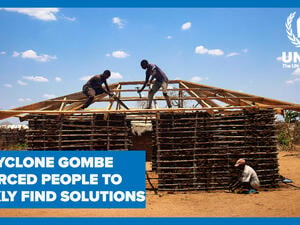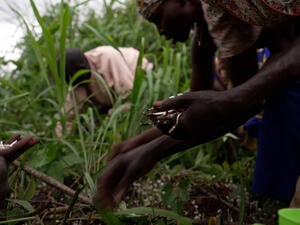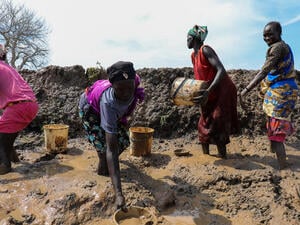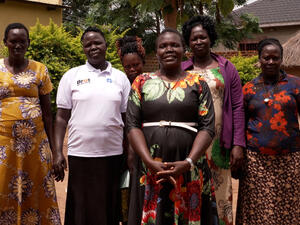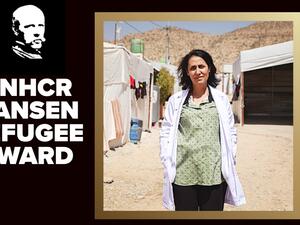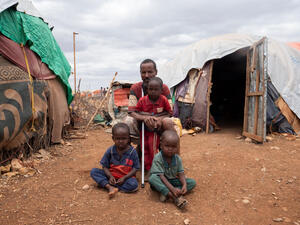South Sudan's revived conflict displaced thousands every day in October
South Sudan's revived conflict displaced thousands every day in October
South Sudan’s conflict, which has spawned one of the world’s biggest humanitarian crises, is continuing to generate vast suffering and huge volumes of displacement. Data for the month of October shows that on average 3,500 people fled to neighbouring countries each day – Uganda, DRC, Ethiopia and Sudan.
In these countries, UNHCR, national authorities and other humanitarian actors are racing to create safe and humane conditions for new arrivals. Nine out of every ten are women and children.
The biggest part of this outflow has been into Uganda, which has seen around 2,400 new arrivals every day since the beginning of October and over a quarter of a million new refugees since the re-eruption of violence in Juba on 7 July.
Most of the arrivals are from the Equatoria regions of South Sudan. They report armed groups harassing civilians, killings and torture of people suspected of supporting opposing factions, burning of villages, sexual assaults of women and girls and forced recruitment of young men and boys.
In recent weeks, refugees are increasingly using informal border crossing points, reportedly due to the presence of armed groups preventing people from using main roads. Many refugees report having had to walk through the bush for days, often without food or water.
A new settlement, Bidibidi, which was opened in August, has become one of the largest refugee-hosting areas in the world. It is now home to 170,000 South Sudanese refugees.
Providing immediate, life-saving assistance, including food, water and shelter, remains UNHCR’s key priority. But severe underfunding is hampering our efforts on the ground.
Water supply is also a major challenge in Bidibidi, where needs are fast growing. Steps are underway to identify urgently-needed water sources in the camp as currently water is being trucked, at great expense, from a treatment plant around 50 kilometres away.
In Ethiopia, some 36,600 new arrivals have been registered since early September. Arrivals have been at an average of 630 people every day.
A new refugee camp, Nguenyyiel, with capacity to accommodate 50,000 people, was opened on 20 October after existing camps in Tierkidi, Jewi and Kule became full. Shelter as well as basic water and sanitation services have been put into place and some 6,200 refugees have already been relocated to Nguenyyiel.
The vast majority of arrivals are from Upper Nile, citing conflict and the fear of renewed fighting as their main reasons for leaving, while those fleeing Jonglei state mostly mentioned food shortages.
Over 85 per cent of the new arrivals are women and children and 65 per cent are children under 18. Over 1,300 unaccompanied children and 6,200 separated children have been registered. Interviews show that many children continue to flee alone, either because their parents are dead or because they were abandoned by or got separated from their family members during their flight.
In Sudan, the number of South Sudanese refugees has now passed the quarter-of-a-million mark. Most refugees arrive in the White Nile state, with some 2,000 new arrivals per month, but sporadic flows into South and West Kordofan states, and East Darfur have also been recorded.
Although east Darfur has received the largest influx, with more 47,000 refugees as of mid-June 2016, most refugees are spread across the country and live outside of organized camps or settlements.
Most refugees entering Sudan, especially women, children and elderly people, arrive in a very poor state. Many have fled areas facing emergency levels of acute malnutrition and have been further weakened by the insecurity and their difficult journey during the rainy season.
In the Democratic Republic of Congo, refugee numbers have gone up, with an influx of 60,000 people, most of whom has arrived since July 2016.
Refugees are settled along the border with South Sudan, where armed groups remain active in some areas. According to our teams on the ground, most refugees arrive from Yei, in Central Equatoria State, with hardly any belongings.
The Ituri province is facing the biggest refugee influx. This week, UNHCR started the transfer of an estimated 40,000 refugees from remote border areas. For the time being, refugees will be sent to Biringi, a site located near the city of Aru, in the northeastern Province of Ituri, while two other sites have been identified. The operation is facing major logistical challenges as many roads are in a very bad state.
Another 4,000 refugees who moved by their own means from the border to Meri in Haut-Uele Province, have been provided drinking water and other basic services. The World Food Programme started a distribution to this group last week.
Refugees in all sites will be given plots of land, construction materials, household goods and agricultural tools to help them become self-sufficient.
For more information on this topic, please contact:
- In Kenya, Terry Ongaro, [email protected], +254 735 337 608
- In Geneva, Cécile Pouilly, [email protected], +41 79 108 2625


